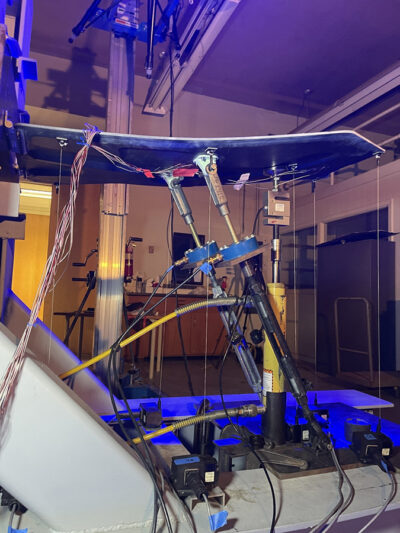Focusing on safety with aircraft icing tests, radiation risk management and wake turbulence studies
By Miles T. Bengtson|December 2020
The Atmospheric and Space Environments Technical Committee encourages the exchange of information about the interactions between aerospace systems and their surroundings.
In the field of aircraft icing, researchers at NASA’s Glenn Research Center in Ohio completed a major test campaign in the Icing Research Tunnel in February. This work builds on a previous collaboration with FAA and ONERA, the French national aerospace research center. The test article was a 6-foot span, full-scale wing section based on NASA’s Common Research Model, an industry-standard airliner model. Researchers performed computational fluid dynamics and icing simulations to determine the expected performance in the tunnel. Their results showed good agreement with the simulations, thus demonstrating the effectiveness of the computational tools and experiments to predict and understand aircraft icing.
Space Environment Technologies of Los Angeles advanced the Automated Radiation Measurements for Aerospace Safety program in early 2020. ARMAS provides real-time dose monitoring to manage radiation risks for commercial aviation and space flights. An ARMAS sensor flew on a Blue Origin New Shepard suborbital test flight in December 2019, and the program was deemed operationally ready in January. ARMAS sensors have already flown on 750 commercial flights and are scheduled to fly on additional suborbital missions. While in flight, dose data are retrieved in real time, downlinked to the ground and assimilated into a model of the global radiation environment. The program’s ultimate objective is to reduce crew and passenger radiation exposure by providing information to operators so they can manage and mitigate radiation risk.
In June, researchers at DLR, the German Aerospace Center, completed analysis on the use of experimental plates to mitigate wake turbulence risks at commercial airports. Medium-sized aircraft currently must maintain a separation of approximately 8 kilometers from larger leading aircraft because wake turbulence from the larger aircraft can destabilize the smaller aircraft. During a six-month experimental campaign conducted in 2019, DLR researchers installed so-called plate lines under the final approach path at Vienna International Airport and studied wake vortex behavior for 9,500 landings. Results show that the plate lines cause wake vortices to dissipate significantly thus reducing encounter risks. This may also allow aircraft separations to be decreased in the future.
In January, researchers at the University of Colorado Boulder achieved operation of a novel electron gun that enables improved laboratory simulation of the space environment. Energetic electrons in space change the material properties of spacecraft exterior surfaces, and electron irradiation laboratory tests are often used to characterize this degradation. However, conventional electrons guns emit electrons at only a single energy, whereas the orbital environment contains electrons across a broad spectrum of energies. The new broad-spectrum electron gun enables spacecraft materials and components to be tested in an orbital-representative environment.
The U.S. Air Force Research Laboratory’s Very Low Frequency Propagation Mapper satellite was deployed in low-Earth orbit in February. The satellite is part of a two-spacecraft mission, along with the Demonstration and Science Experiments satellite, which a SpaceX Falcon Heavy rocket launched into medium-Earth orbit in 2019. In addition to studying Earth’s natural radiation belts, the mission investigates the use of VLF waves to remediate harmful electrons out of artificial radiation belts. Experiments in the 1950s and ’60s showed that detonating a nuclear warhead in space produces an intense radiation belt that could render low-Earth orbit unusable for years. DSX emits VLF waves into the natural radiation belts; the mapper satellite then measures the waves in low-Earth orbit, along with changes in energetic electron fluxes. This tandem experiment is a critical step toward developing technologies to protect our orbital assets from any future nuclear detonations in space.
Contributors: W. Kent Tobiska, Dale Ferguson, Andy Broeren and Frank Holzäpfel



































